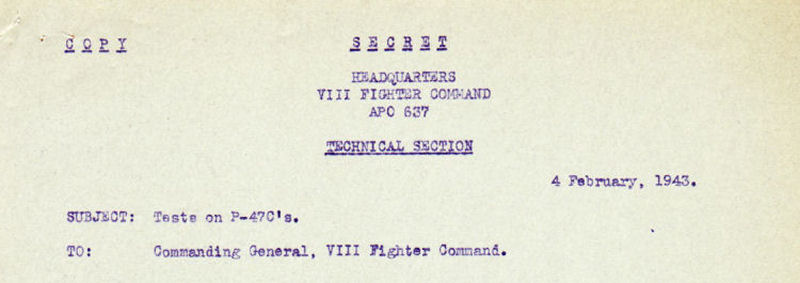1. Acting upon instructions of the Commanding General complete flight tests on the P-47C-2RE and the P-47C-5RE airplanes were carried out by the following personnel:- Lt. Col. Hough, 1st Lt. Smith, 4th Fighter Group, and 2nd Lt. Goodson, 4th Fighter Group. The tests covered approximately 10 days taking full advantage of all flyable weather. Total time flown covered approximately 60 flying hours.
2. Load – all ships for all trials carried the full war load – 300 gallons gasoline, 6 50 cal. Guns, 1800 rounds 50 cal. Ammunition, full armor plating. Total gross weight for trials averaged 13,000 lbs.
3. Flying Characteristics.
a. The airplane is easy to fly so far as landings and take-offs are concerned. It has beautiful aileron control, good elevator control, but very stiff rudder.
b. It is very difficult to trim, being practically impossible to trim it to fly hands off. In addition any slight change in power setting requires the re-trimming of all three movable surfaces.
c. It is fully aerobatic in all standard maneuvers. Care must be exercised, however, to avoid reaching high speeds, unless done intentionally, as the airplane is very clean and accelerates very fast when nose is put down.
d. Stall characteristics are good in the airplane, buffeting shortly before stall is reached. Recovery from spins is normal for high speed airplane, requiring application of full opposite controls before recovery is effected. After the first turn it winds up very fast.
e. It is not entirely satisfactory on instruments, due mainly to trimming difficulties.
4. Speed Trials.
a. Airplanes and crews alternated so as to strike as near an average as possible on all runs.
b. All speed runs were for a full 3 minutes at maximum allowable power for the altitude.
c. Appendix A shows the mean curve of all speed runs made as well as the curves of the P-38, Spit IX and FW 190.
d. The speed curve presented in Appendix A does not necessarily mean that the speeds shown are the maximum speeds for the airplane. It is the mean curve of all the trial runs made under the supervision of this section. It must be remembered that the standard airspeed with which the airplane is equipped has graduations in the high speed range so close together that it is very easy to make a reading error of 10 m.p.h., or more if the air is rough.
5. Climb Trials.
a. These were run by all three pilots using the Air Corps 1/10 second stop watches.
b. All climbs were started at maximum cruise (75% power) climbing at an indicated speed of 165 – 170 m.p.h. indicated.
c. Appendix B shows the results of these climb trials compared with Spit IX and P-38. Again it must be remembered that this is the table of mean results of the trials made, and not necessarily an absolute indication of the airplane’s climb.
6. Fuel Consumption and Tactical Radius of Action. These tests were run by individual ships and in three ships string, and the tactical radius of action is computed conservatively from the highest figures. Using a standard formula of climb – 25,000 ft. at maximum permissible power, 5 minutes combat at full military power, 5 minutes combat at normal rated power (100%) and 10 minutes at 75% power, 5 minutes return at 75% power and the balance of the journey at 67% power, the tactical radius of action is approximately 240 miles.
7. Dive. The airplane accelerates quickly, particularly when rolled into a dive, and generally speaking is very stable through entire speed range. As the speeds increase all controls get very stiff and at speeds over 600 m.p.h. true it is virtually impossible to move the elevator in effecting recovery without the use of trim tab.
8. Fighting Qualities. A complete series of tactical trials is now being run at A.F.D.U. Duxford, and will be covered in a special report.
9. GENERAL COMMENT.
a. The stability of the airplane could be greatly improved, it being very difficult to trim it properly at any time.
b. Rudder control, while adequate, imposes a great physical strain on the pilot due to its stiffness. Admittedly a stiff rudder is excellent for accurate shooting, but if a rudder so stiff that it takes a great amount of physical exertion to properly maneuver the airplane into position for a shot then the stiff rudder is more of a handicap that a help.
c. If possible the time required to retract the landing gear should be shortened. A forced landing caused by engine failure just as the ship became airborne would probably mean landing before the gear had fully retracted, which is not desirable.
d. The relatively complicated hydraulic pressure equalizer for the flaps is far from satisfactory. Although a lever is provided in the cockpit which if actuated will theoretically equalize the pressure on each flap, actually on all ships used for the trials the flaps were continuously giving trouble by one coming down considerably behind the other. The systems were bled thoroughly and check carefully a dozen times during the trials. The airplane is bad enough from a trim standpoint n the landing glide, and becomes a sizeable problem to keep straight and level if the flaps do not open simultaneously.
e. Cockpit heating system is far from adequate and this section is now working on some way to improve this.
Cass S. Hough
Lt. Col., AC.,
Chief of Section
Appendix "A" Comparitive Speeds of P-47C, Spitfire IX, & P-38F with FW 190
Appendix "B" Partial Climbs at Full Power From Level Flight...

